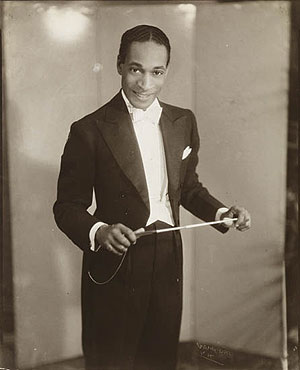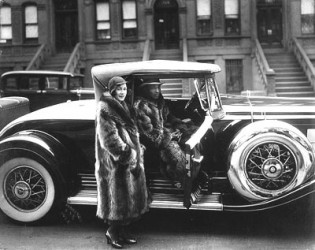No one quite captured the culture, the love and the beauty of the people of Harlem like photographer James Van Der Zee. We all can conjure in our minds his iconic 1932 photo of a black couple wearing raccoon coats proudly showing off a Cadillac on a Harlem street.
It’s a photo I’d love to find at one of my local auctions. But because Van Der Zee was a New York photographer, that may not be likely. Four of his photos were up for sale Tuesday at the African American fine art auction at the Swann Auction Galleries. So were works by several black women artists.
One of Van Der Zee’s photos – I was very happy to see – went for $8,000: “Untitled (Harlem Backyard Banquet)” from the 1920s. Photo above is from the Swann site.
It was a black-and-white photo of an outdoor party in Harlem, and you could practically hear the happy talk and good cheer, and feel the we’re-just-having-a-good-time-being-together camaraderie of the people sitting around tables of food in the backyard. This was an unusual photo by Van Der Zee because most of his works were staged in his studio using props.
 Van Der Zee was the premier photographer of Harlem – the cultural, entertainment and literary center of the universe for black people during the 1920s and 1930s. It was a place where they could just about shut out the ugliness that sought to define them as people. When writer Zora Neale Hurston arrived there in 1925, she said there were so many black people that she thought it was a parade. I learned this bit of information from a PBS documentary on the writer.
Van Der Zee was the premier photographer of Harlem – the cultural, entertainment and literary center of the universe for black people during the 1920s and 1930s. It was a place where they could just about shut out the ugliness that sought to define them as people. When writer Zora Neale Hurston arrived there in 1925, she said there were so many black people that she thought it was a parade. I learned this bit of information from a PBS documentary on the writer.
With his camera, Van Der Zee put Harlem’s people on parade. He photographed politicians, entertainers and the black middle class. And he didn’t shy away from retouching his negatives and prints for a special look.
He was born in Lenox, MA, and came to Harlem in 1906 with his family at age 20, working as a musician (he was a pianist) and forming the Harlem Orchestra. His love, though, was photography; he had gotten his first camera at age 14 back in Lenox. He became a darkroom attendant in 1915 in Newark, NJ, and within two years, opened his own studio in Harlem.
Over the next 50 years, he would chronicle Harlem in photographs and become its most noted photographer. His star faded as the decades passed, but was reignited in the late 1960s when 75,000 of his negatives were discovered and the Metropolitan Museum of Art in New York mounted an exhibit of his works called “Harlem on My Mind.” He died in 1983.
 I don’t often come across studio shots of black people at auctions, but I find lots of them of white families, sometimes in those nice old fancy paper frames. Any photos of black people are normally snapped up quickly and expensively by other bidders.
I don’t often come across studio shots of black people at auctions, but I find lots of them of white families, sometimes in those nice old fancy paper frames. Any photos of black people are normally snapped up quickly and expensively by other bidders.
My auction buddy Janet recently missed out on four small photos of black women in nice coifs that were part of a tray lot of jewelry. She had to leave the auction early, left a bid that was way too low and was out-bidded.
She apparently forgot that photos of black folks – along with black memorabilia – are hot items.
At the Swann auction, the three other Van Der Zee photos went for less: “The Good Shepherd,” a 1933 photo of a church lady in white uniform, $1,800. “The Director,” a nattily dressed choral director in tails (1930), $800. “Religious Play #1,” a 1935 church play, $1,000.
Michael Rosenfeld Gallery in New York mounted an exhibit of Van Der Zee’s photographs in 2002.



Wonderful photographer!!! I just love his work!!